Top 10 Characteristics of High-Quality Kitchen Cabinets
High-quality kitchen cabinets should look stunning and provide functional, easy-to-use storage at least twenty or thirty years. However, many people have cabinet problems much sooner than this, reporting issues such as crooked doors, sagging, deteriorating drawers, scratched and dented faces, loose hinges, and warping boxes. These problems occur because of low quality cabinet construction. Not only do low-quality cabinets lead to functional and aesthetic issues for homeowners, but they also create higher-than-expected costs in installation and maintenance. To shop smart and avoid problems down the road, look for the following characteristics of well-built, high-quality cabinets.
1. All-plywood construction
Cabinet boxes are typically built of plywood or particleboard. The most robust cabinets have full plywood sides and backs to stay square during delivery and installation, handle the weight of heavy countertops, and resist damage from moisture. Particleboard is a less expensive alternative. It is vulnerable to damage from moisture and crushing, as well as difficult-to-repair blow-outs at screws and joints.
• All-plywood construction (APC) Plywood has more holding power with screws, fasteners, and glue than particleboard does. Plywood is made with layers of wood running both lengthwise and crosswise in a way that makes plywood stronger. It has a much higher tolerance for moisture than particleboard does, which is an essential feature to consider around areas with sinks, faucets, and running water. Plywood will bear weight over long periods and is also much more resilient to damage such as blow-outs, dings, and dents.
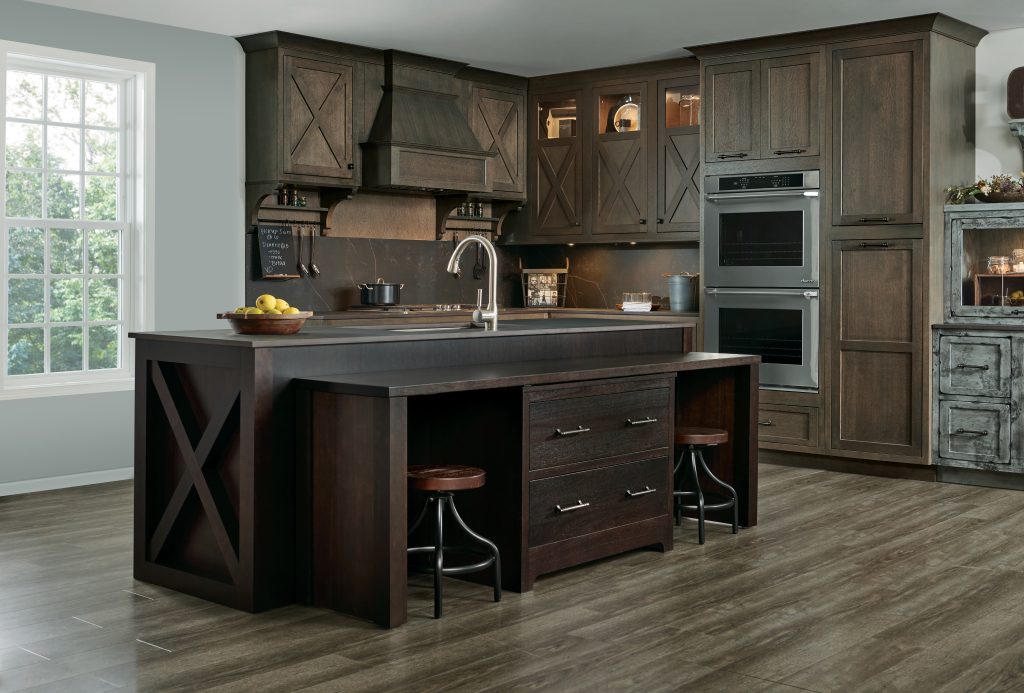
• Particleboard
There are many names for particleboard: medium density fiberboard (MDF), engineered wood, hardboard, substrate, furniture board, etc. However you call it, particleboard is made by pressing wood particles together at high temperature with glue. It doesn’t typically expand or contract as the climate becomes warmer or colder but is more susceptible to damage caused by collision or moisture. The particles are heavy and do not have the same per-square-foot strength of plywood. Sagging cabinet shelves are often a sign of deteriorating particleboard construction.
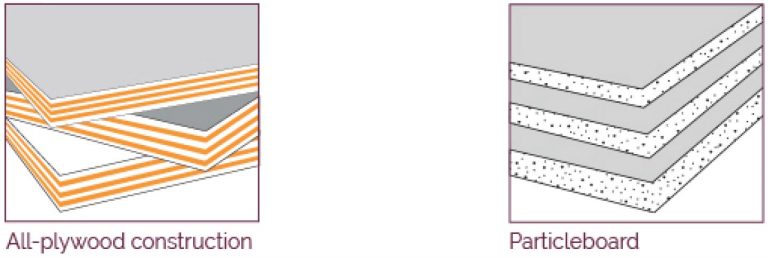
2. Full-height back panels
Cabinet back construction affects the durability and ease of installation. The most robust cabinet construction uses a (3/8-inch or more), full-plywood, full-back panel. Less expensive methods use thin panels, metal hangs rails and brackets, rails, and picture-frame construction. Weak back panels can result in falling cabinets. Choose plywood back construction to keep cabinets secure and accurate in your kitchen.
• Solid, full-height plywood The most durable cabinet construction uses a heavy (3/8-inch or more), full-plywood, full-back panel. This panel allows the cabinet to be directly attached to the studs of the wall at any point on the cabinet back. Since the strength of the plywood extends from top to bottom and side to side, there is no need for hanging rails. If a cut need be made to accommodate wiring or plumbing, the back generally will retain its integrity without additional reinforcements.
• Other less expensive methods These methods use thin panels, and metal hangs rails and brackets, rails, and picture-frame construction. They either omit the back panel entirely (so you can see the wall) or incorporate a 1/8-inch to ¼-inch particleboard panel that is the height of the cabinet. If a rail needs to be cut to accommodate wiring or plumbing, additional reinforcement will be necessary.
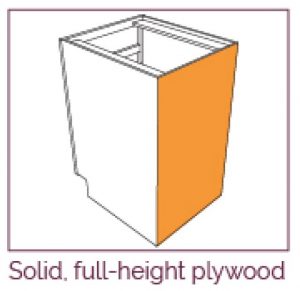
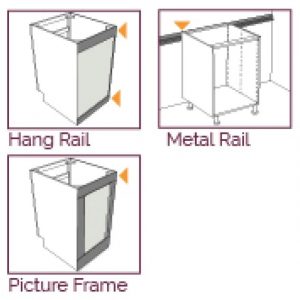
3. Soft-close hinges
Cabinet hinges are one of the most critical components of a kitchen cabinet – you can’t open and close a door without them. Inferior hinges can cause stiff, loose, or uneven doors, as well as doors that won’t close.
• Soft-close, steel, 6-way adjustable hinges A quality cabinet hinge has a soft close mechanism built into the nickel plated, hardened steel hinge. The hinge should be adjustable six ways: in-out, up-down, and left-right so that the hinges can be adjusted when cabinet doors expand and contract during seasonal changes. Every one of the cabinet manufacturers that Premier Kitchens and Cabinets has chosen to work with utilize either Blum hinges or Salice hinges. Both brands offer standard full-overlay, and inset concealed hinge door hinges that are six way adjustable. Hinges need to stand up to constant use, and both of these hinges have been tested and meet or exceed the American National Standard Institute’s requirements.
• Other hinges
There are thousands of hinges available to cabinet manufacturers. Be wary of cabinet manufacturers that use low-end hinges that only provide four-way adjustability, or who don’t back their product with a lifetime warranty.
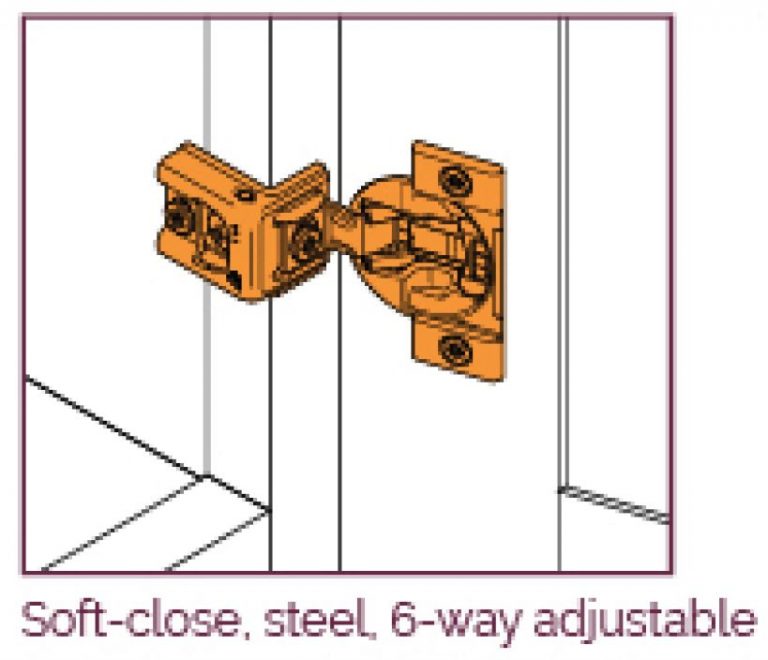
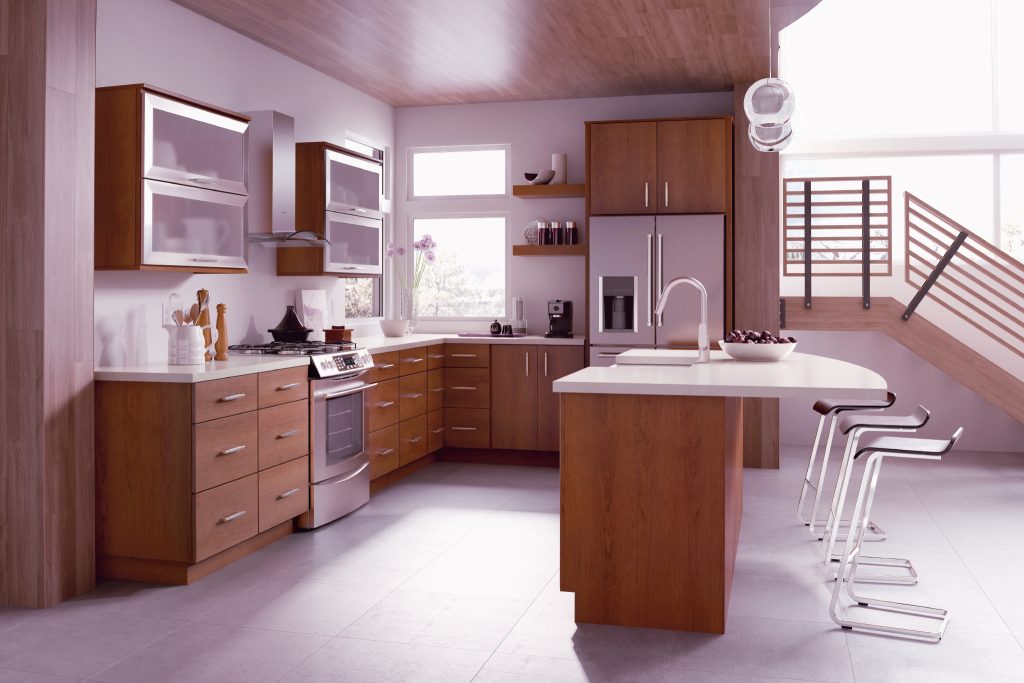
4. Undermount, soft-close drawer glides
High-quality drawer glides (slides) are critical to supporting the smooth and silent movement of your cabinet drawers over years of hard use. The more weight your drawers carry, the greater the necessity for heavy-duty glides. Weak glides could lead to sagging, loose, or stick cabinet drawers.
• Undermount, steel, soft-close glides
Undermount, steel, soft-close drawer glides should extend to provide full access to the entire drawer. Ball bearings and steel guides provide smooth operation and longer wear. Mounted beneath the drawer box, the glides should be rated to support a heavy load: at least 90 pounds. Adjustable glides with a soft-close (anti-slam) dampening system will be almost silent when opening and closing the drawer.
• Other drawer glide systems
There are hundreds of drawer-glide systems and mechanisms used by cabinet manufacturers. A common construction uses epoxy-coated metal with plastic rollers. These materials are subject to wear. Center-mount and side-mount glides rarely provide full access; instead, about 25 percent of the drawer remains inside the cabinet, making it difficult to reach the back of the drawer. Side-mounted glides reduce the width of the drawer, thus reducing storage space. Side-mount glides are never soft close. At the bottom of the quality scale, is a single center-mounted wooden or metal glide sliding through a plastic brace on the cabinet.
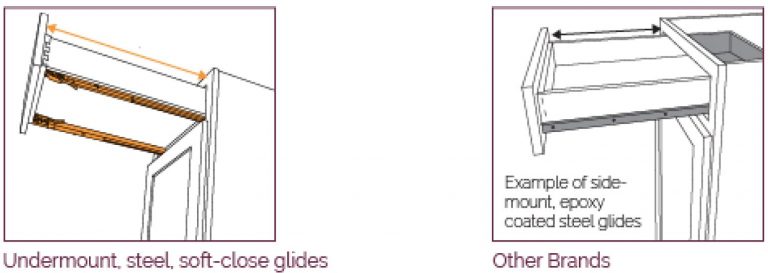
5. Hardwood dovetail drawer boxes
If your drawers are bending and bowing, or the front faces are falling off, then you should consider a higher quality drawer box. The drawer boxes and joints are among the first things to fall apart in low-end kitchen cabinetry. Lesser quality construction, usually secured with staples and notched butt joints, do not have the strength of the dovetail joint, where the drawer box sides are milled to include interlocking teeth.
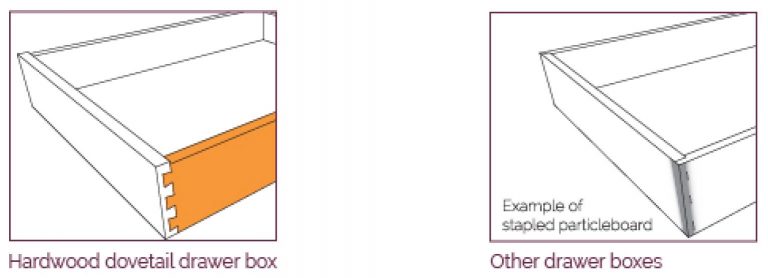
•Hardwood dovetail drawer box
Solid hardwood drawer boxes with dovetail joints and heavy plywood bottoms set the standard for quality American cabinetry because of their long-lasting durability and the beauty of the joint. A high-quality hardwood drawer box will have sides of 5/8-inch or thicker solid maple or birch. The sides meet at dovetail joints, where the strength of the joint comes from the wood itself. A strong plywood drawer bottom, fully captured on four sides in dado (grooved) joints, is glued and nailed in place.
•Other materials and construction
A wide range of materials and construction methods are used for cabinet drawers. Particleboard, plywood, metal, and plastic are common materials. Construction methods vary greatly. Lesser quality drawer boxes use butt or rabbet (notched) joints secured with staples to hold the sides together. These may have particle board drawer bottoms.
6. Fully assembled in the factory
Fully assembled cabinets are completely built at the factory, boxed, and shipped ready to install. Ready-to-assemble (RTA) cabinets are designed to be assembled by a homeowner or contractor. The differences to the consumer include price, convenience, and construction strength.
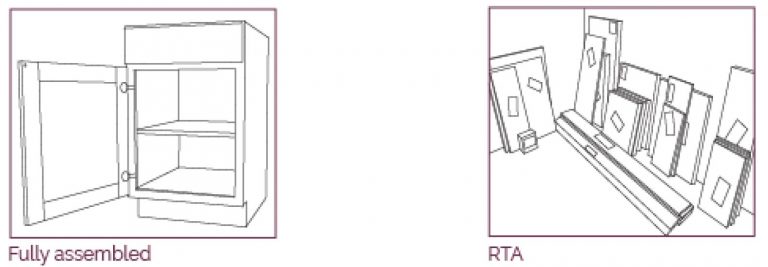
•Fully assembled cabinets
Cabinets designed to be fully assembled in the factory are stronger and more durable. Factory construction methods join wood parts using dovetail joints, hot and cold glue, power fasteners, and other industrial techniques. In this wood-to-wood construction, the pieces bond on a microscopic level that increases the strength of the cabinet. A cabinet is built, packed and shipped as a unit, doors, and drawers intact, ready to be installed.
•Ready-to-assemble (RTA)
RTA cabinets ship in parts (cabinet, face frame, drawers, drawer glides, inserts, doors, and hardware) and are designed to be assembled at the construction site. RTA cabinets are generally less expensive, but their assembly can take significant time. Because of the limitations of home assembly methods, RTA cabinets generally are not as strong or durable as those assembled in a factory.
7. Face frames
A framed cabinet has a solid hardwood frame attached to the front of the cabinet box. Door hinges and drawer glides are attached to the frame. In a frameless cabinet, doors are attached directly to the cabinet box sides. The two methods of construction are significantly different in appearance, and depending on the construction methods, they can vary widely in strength and stability. Installation costs are typically higher for frameless cabinets.
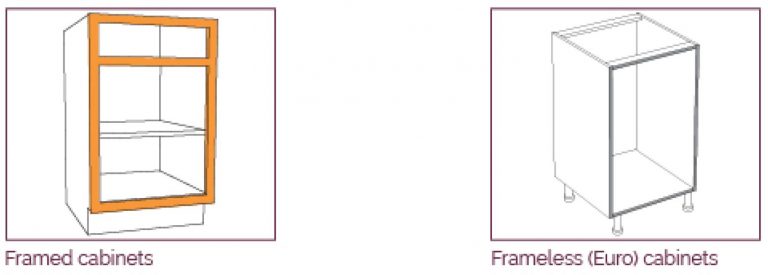
•Framed cabinets
The face frame provides a solid, hardwood base for hinges and drawer glides. Furthermore, the face frame provides stability to help keep the cabinet box square during shipping and installation. There are three styles of framed cabinetry, referred to by the amount of frame revealed: partial overlay, full overlay, and inset.
•Frameless (Euro) cabinets
Frameless, also known as European-style, cabinets have no frame on the front of the cabinet box. Frameless cabinets are a full overlay, revealing approximately 1/8-inch around drawer fronts and cabinet doors. The side panels are thicker than in a framed cabinet, allowing drawer glides and door hinges to be attached directly to the cabinet side walls. Most frameless cabinets are constructed from particleboard, leading to door hinges that may come loose over time. The installation of frameless cabinets must be, and the install area must be perfectly level and plumb since even tiny misplacements will be perceivable. Therefore, some installers will charge more to install frameless than framed cabinets.
8. Customizability and modifications
Cabinets with custom modifications provide many choices of sizes, styles, and specialty features, tailored to the unique needs and space of your kitchen. Many homeowners find that stock manufacturers offer too few styles and sizes, but fully custom cabinet manufactures cost too much. There is a middle ground: semi-custom cabinets with modifications.
Semi-custom cabinets with modifications provide a wide range of sizes, styles, and specialty cabinets at a reasonable price. The manufacturer builds each kitchen as a custom project, saving on production costs by starting with a basic cabinet line. Modifications allow a high degree of customization, but that cost is restricted to specific cabinet units.
Modifications include up to 1/8-inch incremental adjustments in cabinet box sizes, finished interiors, beadboard ends or interiors, glass-ready open-front or mullion doors, storage units, angled end cabinets, and non-conventional uses of standard cabinet boxes. With those options, an experienced kitchen designer can provide you a high degree of personalization.
9. Lifetime Warranty and Industry Certification
While the warranty might not tell you about the quality of the cabinet per se, it gives you a clue about how far the manufacturer is willing to stand behind their product. If they assure a lifetime warranty, it implies that they have faith in the cabinet quality. If they provide no warranty well, you can decide for yourself what that means. Poor quality cabinetry will often begin to break down after 5 to 10 years of use. By that time, their warranties may have expired. Given that kitchen cabinets are one of the most expensive items you will ever purchase for your home, a lifetime warranty can be the assurance you need that your cabinets will serve you for the entire period you reside in your home.
•Lifetime limited warranty
A lifetime limited warranty is an assurance that the manufacturer will guarantee the operation of cabinetry for as long as the original purchaser owns the product. This warranty is typically limited to repair or replacement.
•Short-term or no warranty
A large percentage of manufacturers only offer one-, five-, or ten-year limited warranties, while others offer no warranty at all. Be cautious if considering cabinets with no or minimal warranties. If the cabinets fail, there is no recourse for the consumer.










